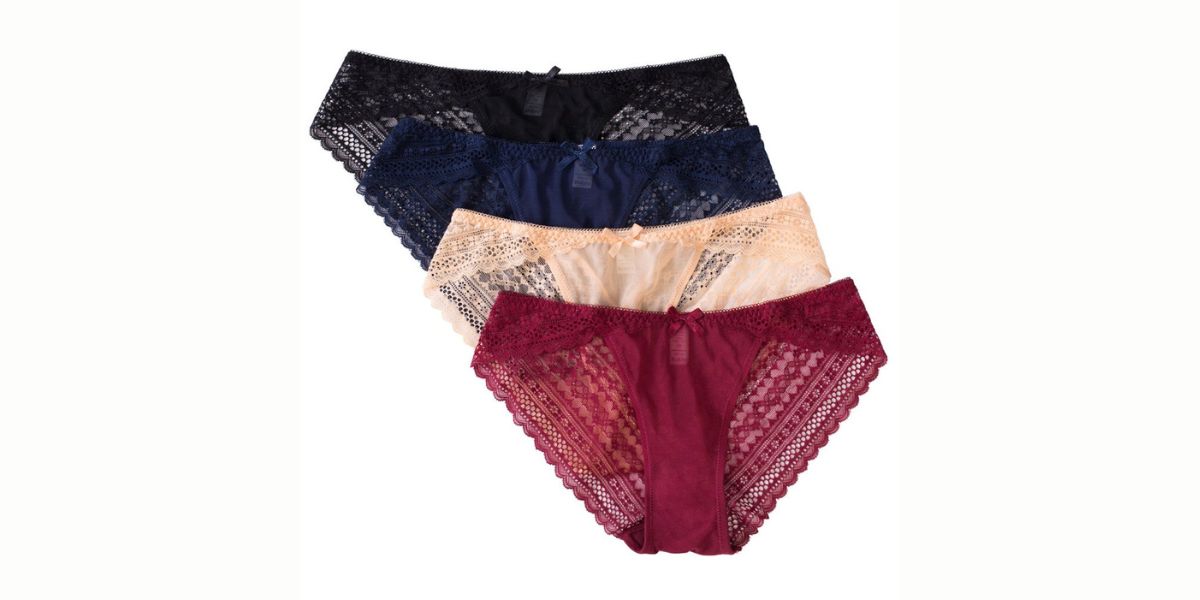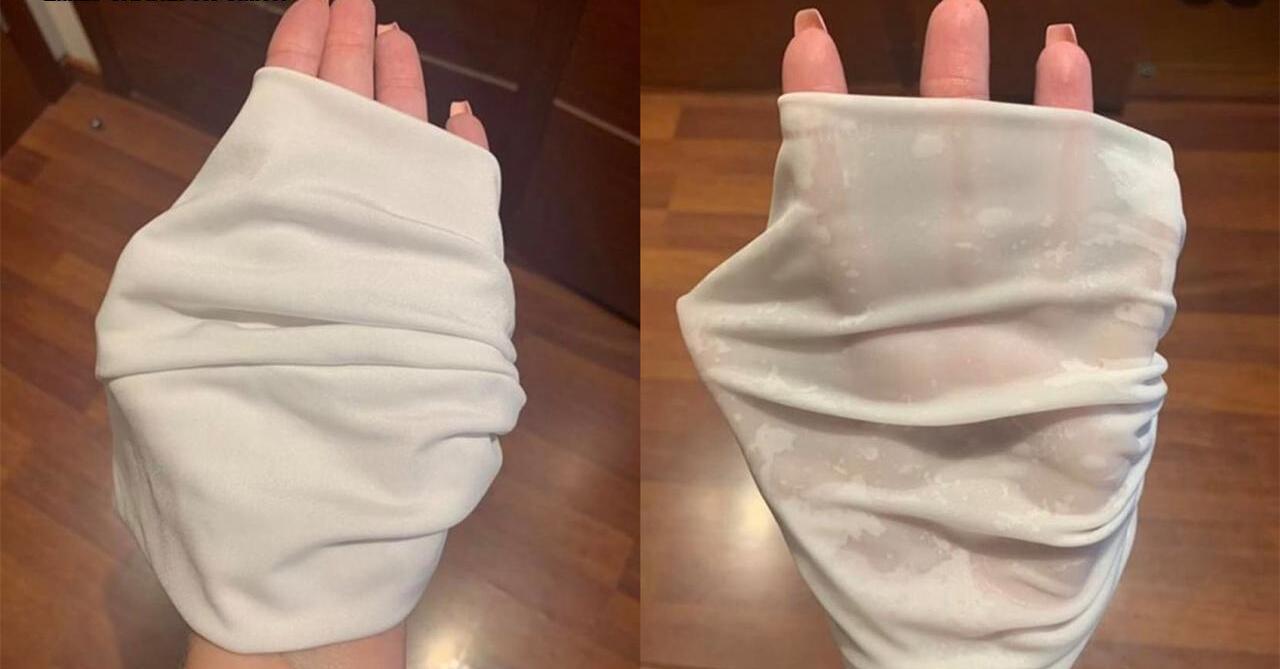Home>FAQs>What Does It Mean When Your Underwear Is Always Wet


FAQs
What Does It Mean When Your Underwear Is Always Wet
Modified: August 28, 2023
Discover the reasons behind why your underwear may be consistently wet and find answers to general questions on this common issue.
(Many of the links in this article redirect to a specific reviewed product. Your purchase of these products through affiliate links helps to generate commission for Under-tec.com, at no extra cost. Learn more)
Table of Contents
Introduction
Have you ever experienced the discomfort and embarrassment of constantly having wet underwear? It can be a frustrating and perplexing issue to deal with. Persistent wetness in your underwear may leave you wondering what could be causing it and if it’s something to worry about. In this article, we will explore the various factors that can contribute to this condition and provide insights into what it may mean when your underwear is always wet.
While occasional wetness in your underwear is normal, experiencing it on a regular basis can be a cause for concern. It’s important to understand that there can be several different reasons for this issue, ranging from simple lifestyle factors to more complex medical conditions. By identifying the underlying cause, you can take the necessary steps to manage or address the problem effectively.
In the following sections, we will delve into the possible causes of persistent wetness in your underwear and explore the factors that may contribute to this condition. Please note that the information provided here is for educational purposes only, and it is always recommended to consult with a healthcare professional for a proper diagnosis and personalized advice.
Possible Causes of Persistent Wetness
When your underwear is consistently wet, there can be several potential causes to consider. It is important to pinpoint the underlying factor in order to determine the appropriate course of action. Here are some possible causes of persistent wetness:
- Excessive Sweating: Excessive sweating, also known as hyperhidrosis, can lead to wetness in your underwear. This condition can affect various parts of the body, including the underarms, hands, feet, and groin area. If you notice that your underwear is frequently damp, even when you’re not engaged in physical activity or in a warm environment, excessive sweating may be the culprit.
- Urinary Incontinence: Urinary incontinence refers to the involuntary leakage of urine. It is more common than you might think and can affect individuals of all ages. The bladder muscles may weaken due to factors such as age, pregnancy, childbirth, or certain medical conditions, leading to urine leakage. If you experience urine leakage and wetness in your underwear, especially when you cough, sneeze, laugh, or exercise, urinary incontinence might be the cause.
- Vaginal Discharge: Vaginal discharge is a normal occurrence in women and serves the purpose of keeping the vagina clean and lubricated. However, certain factors such as hormonal changes, infections, or other underlying health conditions can cause an increase in the amount of discharge. If you notice excessive vaginal discharge, it could result in wetness in your underwear.
- Medications and Medical Conditions: Certain medications, including diuretics and anticholinergics, can increase urine production and contribute to wetness in your underwear. Additionally, medical conditions such as diabetes or urinary tract infections can lead to increased urine output, resulting in persistent wetness. If you suspect that your medications or an underlying medical condition may be the cause, it is important to consult with your healthcare provider for further evaluation.
- Hygiene and Lifestyle Factors: Poor hygiene practices, such as not changing your underwear regularly or not maintaining proper genital hygiene, can contribute to wetness and discomfort. Additionally, wearing tight or non-breathable underwear and pants can trap moisture and create a moist environment, leading to increased wetness. It is important to prioritize good hygiene habits and choose undergarments made from breathable materials to help alleviate this issue.
These are just a few possible causes of persistent wetness in your underwear. It is important to remember that while some causes may be temporary or easily managed, others may require medical attention. In the next sections, we will explore when to seek medical attention and the available diagnosis and treatment options for this condition.
Excessive Sweating
Excessive sweating, also known as hyperhidrosis, can be a potential cause of persistent wetness in your underwear. Hyperhidrosis can affect different parts of the body, including the underarms, hands, feet, and groin area. When you experience excessive sweating in the groin area, it can result in dampness and discomfort in your underwear.
There are two types of hyperhidrosis – primary and secondary. Primary hyperhidrosis is typically localized and not caused by an underlying medical condition. It often begins during adolescence and can have a significant impact on daily life. On the other hand, secondary hyperhidrosis is usually generalized and can be caused by medical conditions, such as diabetes, thyroid issues, or menopause, among others.
If you notice that your underwear is consistently wet, even when you’re not engaging in physical activity or in a warm environment, excessive sweating could be the cause. Other signs that may indicate hyperhidrosis include visibly damp armpits or feet, frequent clothing changes due to excessive perspiration, and noticeable sweating that interferes with daily activities.
Managing excessive sweating in the groin area can be challenging, but there are several strategies you can try:
- Avoid triggers: Pay attention to any triggers that may worsen your sweating, such as certain types of clothing fabrics, spicy foods, caffeine, or alcohol. By avoiding or minimizing exposure to these triggers, you may be able to reduce excessive sweating.
- Use antiperspirants: Look for antiperspirants specifically designed for the groin area. These products contain ingredients that can help reduce sweat production and keep the area dry. However, avoid using antiperspirants on broken or irritated skin.
- Wear breathable clothing: Opt for loose-fitting underwear made from breathable materials, such as cotton, that allow air circulation and absorb moisture. Avoid tight or synthetic fabrics that can trap moisture and exacerbate sweating.
- Practice good hygiene: Maintain good hygiene practices by showering regularly and thoroughly cleaning the groin area. Dry the area properly before putting on fresh underwear to reduce dampness and prevent any potential odor or irritation.
- Consider medical treatments: If excessive sweating significantly impacts your quality of life and self-confidence, it may be beneficial to explore medical treatment options. These can include prescription antiperspirants, iontophoresis (a procedure that uses electric currents to temporarily block sweat), medications, or even botulinum toxin injections to reduce sweat production.
If you are experiencing persistent wetness in your underwear due to excessive sweating, it is advisable to consult with a healthcare professional who can assess your condition and provide appropriate guidance and treatment options.
Urinary Incontinence
Urinary incontinence is another potential cause of persistent wetness in your underwear. It refers to the involuntary leakage of urine, and it can occur in varying degrees of severity. This condition can be embarrassing and inconvenient, but it is more common than you might think and can affect individuals of all ages.
There are several types of urinary incontinence, including stress incontinence, urge incontinence, overflow incontinence, and mixed incontinence. Each type has different underlying causes and triggers:
- Stress incontinence: This type of incontinence occurs when there is increased pressure on the bladder due to activities such as coughing, sneezing, laughing, or exercising. It is often caused by weakened pelvic floor muscles, which can be a result of childbirth, pregnancy, hormonal changes, or certain surgeries.
- Urge incontinence: Urge incontinence, also known as overactive bladder, involves a sudden and intense urge to urinate, followed by involuntary urine leakage. It is caused by abnormal bladder contractions and can be triggered by various factors, such as drinking excessive fluids, urinary tract infections, certain medications, or neurological conditions.
- Overflow incontinence: Overflow incontinence occurs when the bladder does not empty completely, causing it to overflow and result in small amounts of urine leakage. It can be caused by factors such as weak bladder muscles, bladder obstruction, or nerve damage.
- Mixed incontinence: Mixed incontinence refers to a combination of both stress and urge incontinence. It is common for individuals to experience symptoms of both types.
If you are experiencing urinary incontinence, it is essential to consult with a healthcare professional for a proper diagnosis and personalized treatment plan. The treatment options for urinary incontinence will depend on the type and severity of your condition. They may include:
- Pelvic floor exercises: Strengthening the pelvic floor muscles through exercises, such as Kegels, can help improve bladder control and reduce urine leakage.
- Behavioral techniques: Adopting techniques like scheduled voiding, setting bathroom timers, and maintaining a healthy fluid intake can help manage urinary incontinence symptoms.
- Medications: In some cases, medications may be prescribed to help relax the bladder muscles, reduce urinary frequency, or manage overactive bladder symptoms.
- Medical devices: Depending on the type of incontinence, your healthcare provider may recommend the use of medical devices such as urethral inserts or pessaries to provide support and control urine leakage.
- Surgical procedures: In severe cases or when other treatment options have been ineffective, surgical interventions may be considered. These can include procedures to support the urethra, bladder neck suspensions, or sling procedures.
Remember, urinary incontinence is a common issue, and there are effective treatment options available. Speaking with a healthcare professional can help you find the most suitable approach to manage urinary incontinence and reduce the wetness in your underwear.
Vaginal Discharge
Vaginal discharge is a common occurrence in women and serves the purpose of keeping the vagina clean and lubricated. However, when there is an excessive amount of discharge, it can contribute to wetness in your underwear. It is essential to note that vaginal discharge can vary in consistency, color, and odor throughout your menstrual cycle, and it can be influenced by various factors such as hormonal changes, menstrual cycle phase, sexual arousal, pregnancy, and certain health conditions.
Increased vaginal discharge may be a result of several factors:
- Hormonal changes: Fluctuations in hormone levels, especially during ovulation or before menstruation, can lead to an increase in vaginal discharge. This is typically considered normal and does not require medical attention.
- Infections: Certain vaginal infections, such as yeast infections or bacterial vaginosis, can cause an abnormal increase in vaginal discharge. These infections may also be accompanied by symptoms such as itching, burning, redness, or a strong odor. If you suspect an infection, it is important to consult with a healthcare professional for diagnosis and appropriate treatment.
- Sexually transmitted infections (STIs): STIs, such as chlamydia, gonorrhea, or trichomoniasis, can cause changes in vaginal discharge. If you are sexually active and experiencing abnormal discharge along with other symptoms such as itching, pain during intercourse, or genital sores, seeking medical attention is crucial for diagnosis and treatment.
- Cervical changes or abnormalities: Certain conditions, such as cervical polyps or cervical cancer, can cause an increase in vaginal discharge. If you notice persistent changes in your discharge, especially if it is accompanied by abnormal bleeding or pain, it is important to consult with your healthcare provider for further evaluation.
- Allergic reactions or irritation: Vaginal discharge can also be triggered by allergic reactions to certain products, such as soaps, perfumes, or condoms. Additionally, tight clothing or underwear made from non-breathable fabrics can cause irritation and an increase in discharge. Identifying and avoiding potential irritants can help alleviate the issue.
If you notice an increase in vaginal discharge or any changes in its color, odor, or consistency, it is important to pay attention to accompanying symptoms and consult with a healthcare professional if necessary. They can assess your condition, perform any necessary tests, and recommend appropriate treatment options, such as antifungal medications, antibiotics, or lifestyle changes.
It is important to practice good genital hygiene, including regular washing with mild, fragrance-free soap and water. However, avoid douching, as it can disrupt the natural balance of the vagina and lead to irritation or infection.
Remember, vaginal discharge is a normal bodily function, but any significant changes or accompanying symptoms should be evaluated by a healthcare professional to ensure proper diagnosis and management.
Medications and Medical Conditions
Medications and underlying medical conditions can also contribute to persistent wetness in your underwear. It’s important to be aware of how certain medications and health conditions can affect your body’s normal functions, including urinary control and vaginal discharge. Here are some factors to consider:
- Medications: Certain medications can contribute to increased urine production, leading to wetness in your underwear. Diuretics, commonly prescribed to treat conditions such as high blood pressure or heart failure, increase urine output as they help eliminate excess fluid from the body. Additionally, medications with anticholinergic effects, often used to manage conditions like overactive bladder or asthma, can contribute to urinary retention and potentially cause wetness. If you suspect that your medication may be the cause, it’s essential to consult with your healthcare provider for a review of your medication regimen and potential alternative options.
- Medical conditions: Various medical conditions can affect urinary control and vaginal discharge, leading to wetness in your underwear. Diabetes, for example, can lead to increased urine production due to elevated blood sugar levels. Similarly, urinary tract infections (UTIs), bladder infections, or kidney infections can cause a frequent urge to urinate and potentially lead to urine leakage. Other conditions, such as hormonal imbalances, thyroid problems, or neurological disorders, may also impact urinary and vaginal health. If you have an underlying medical condition and are experiencing persistent wetness in your underwear, it is important to consult with your healthcare provider to manage and address the underlying condition effectively.
It’s crucial to communicate openly with your healthcare provider about any medications you are taking and any medical conditions you have. They can help determine if there is a connection between your medication, medical condition, and the persistent wetness in your underwear. Proper management and possible adjustments to your treatment plan may help alleviate this issue.
In some cases, adjusting medication dosages, changing medications, or receiving treatment for underlying conditions can help reduce or eliminate the wetness in your underwear. Always consult with a healthcare professional for guidance and personalized advice regarding your specific situation.
Hygiene and Lifestyle Factors
Hygiene and lifestyle factors can play a significant role in the wetness you experience in your underwear. Certain behaviors and choices can contribute to increased moisture and discomfort. Here are some hygiene and lifestyle factors to consider:
- Poor hygiene practices: Inadequate hygiene practices, such as not changing your underwear regularly or not properly cleaning the genital region, can contribute to wetness. It is essential to maintain good hygiene habits, including changing into clean, dry underwear daily and washing the genital area with mild, fragrance-free soap and water regularly.
- Choice of underwear: The type of underwear you choose can have an impact on how much moisture is retained. Tight-fitting, non-breathable materials can trap moisture and create a moist environment that is conducive to wetness. Opt for underwear made of breathable fabrics, such as cotton, that allow for air circulation and help absorb moisture.
- Clothing choices: Wearing tight-fitting pants or clothing made of non-breathable fabrics can also contribute to increased moisture in the genital area. Opt for loose-fitting clothing that allows air circulation and helps maintain dryness.
- Excessive sweating: If you engage in activities that cause excessive sweating, such as intense physical exercise or spending time in a hot environment, it can contribute to wetness in your underwear. To minimize the impact of sweating, consider wearing moisture-wicking underwear and changing into fresh, dry underwear immediately after sweating.
- Stay hydrated: Adequate hydration is essential for overall health, but excessive fluid intake can lead to increased urine production and potential wetness. It’s important to find a balance and ensure you are drinking enough water without overhydrating.
By being mindful of your hygiene practices and making appropriate lifestyle choices, you can help minimize excessive moisture and reduce the wetness you experience in your underwear. Additionally, paying attention to your body’s signals and adjusting your habits accordingly can contribute to improved comfort and freshness.
Remember, your hygiene routine and lifestyle choices are within your control, and making small adjustments can make a significant difference. If you have implemented good hygiene practices and made appropriate lifestyle changes but are still experiencing persistent wetness, it’s important to consult with a healthcare professional for further evaluation and guidance.
When to Seek Medical Attention
Experiencing persistent wetness in your underwear can sometimes be a cause for concern and may warrant seeking medical attention. While occasional wetness can have various causes, there are certain situations where it is essential to consult with a healthcare professional. Here are some signs that indicate it may be time to seek medical attention:
- Severe or sudden increase in wetness: If you notice a significant change in the amount of wetness in your underwear, especially if it is sudden and accompanied by other symptoms, it is advisable to consult with a healthcare professional. This may indicate an underlying condition that requires evaluation and treatment.
- New or unusual symptoms: If you experience new or unusual symptoms alongside persistent wetness, such as pain, discomfort, itching, burning, odor, or changes in the color or consistency of your vaginal discharge or urine, it is important to seek medical attention. These symptoms may indicate an infection, hormonal imbalance, or other underlying health conditions.
- Impact on daily life: If the wetness in your underwear significantly affects your quality of life, causing discomfort, embarrassment, or interfering with your daily activities or relationships, it is crucial to discuss this with a healthcare professional. They can assess the situation and provide appropriate guidance and treatment options to help manage and improve your situation.
- Persistent or worsening symptoms: If the wetness in your underwear persists or worsens despite implementing hygiene practices, lifestyle changes, or over-the-counter remedies, it is important to seek medical attention. This may indicate an underlying condition that requires a proper diagnosis and targeted treatment.
- Concerns about medications or underlying health conditions: If you suspect that your medications or an underlying medical condition may be contributing to the wetness in your underwear, it is important to consult with a healthcare professional. They can review your medical history, assess your symptoms, and provide appropriate guidance or adjust your treatment plan if necessary.
Remember, while it is natural to have some wetness in your underwear from time to time, persistent wetness should not be ignored, particularly if it is accompanied by other symptoms or impacting your daily life. A healthcare professional can help identify the underlying cause and recommend appropriate treatment options based on your specific situation.
It is always better to err on the side of caution and seek medical advice when unsure or concerned about persistent wetness in your underwear.
Diagnosis and Treatment Options
When experiencing persistent wetness in your underwear, it’s important to undergo proper diagnosis in order to identify the underlying cause. This will help determine the most appropriate treatment options. Here are some common diagnostic methods and treatment approaches:
- Medical history and physical examination: A healthcare professional will begin by asking about your medical history, including any medications you are taking, lifestyle factors, and any symptoms you are experiencing. They may also perform a physical examination to assess your pelvic floor strength, check for signs of infection or inflammation, and evaluate other relevant factors.
- Urinalysis: A urine test may be conducted to check for any signs of infection, such as a urinary tract infection (UTI), which can lead to increased wetness in your underwear. The urine analysis can also provide valuable information about the presence of blood or other abnormalities.
- Blood tests: Blood tests may be ordered to assess hormone levels, detect any underlying medical conditions (such as diabetes or thyroid abnormalities), or identify signs of inflammation or infection.
- Imaging tests: Depending on the suspected cause, your healthcare provider may order imaging tests, such as ultrasound or MRI, to visualize the pelvic area and assess the structures and organs (such as the bladder and reproductive organs).
- Specialized tests: In some cases, specialized tests may be conducted to assess bladder function, measure urine flow rates, or evaluate urethral or sphincter function. These tests can provide valuable insights into the specific cause of the wetness in your underwear.
The treatment options for persistent wetness in your underwear will depend on the underlying cause. Here are some common approaches:
- Lifestyle modifications: In many cases, implementing lifestyle changes can help manage and alleviate wetness. This may include adopting proper hygiene practices, wearing breathable underwear, making dietary adjustments, managing fluid intake, and practicing pelvic floor exercises.
- Medications: Depending on the underlying cause, your healthcare provider may prescribe medications such as anticholinergics, antifungals, hormonal treatments, or antibiotics. These medications are targeted to address specific conditions, such as overactive bladder, infections, hormonal imbalances, or urinary tract issues.
- Physical therapy: For conditions related to weak pelvic floor muscles or muscular dysfunction, physical therapy may be recommended. A physical therapist can guide you through exercises and techniques to improve pelvic floor strength and control.
- Surgical interventions: In some cases, surgical procedures may be necessary to address underlying structural issues, such as bladder prolapse, urethral obstruction, or other conditions causing persistent wetness. These procedures aim to restore proper function and alleviate symptoms.
- Behavioral therapies: Behavioral therapies, including bladder training, prompted voiding, and biofeedback, can be effective in managing conditions like overactive bladder or stress incontinence by retraining the bladder and improving control.
It’s important to remember that the treatment approach will depend on the specific diagnosis, severity of symptoms, and individual factors. Consulting with a healthcare professional is crucial for a proper diagnosis and to determine the most appropriate treatment options for your situation.
Tips for Managing Persistent Wetness
If you are experiencing persistent wetness in your underwear, there are several tips and strategies you can try to help manage and reduce the discomfort associated with it. While these tips can provide some relief, it is important to consult with a healthcare professional for a proper diagnosis and personalized advice. Here are some tips for managing persistent wetness:
- Maintain good hygiene: Practice good genital hygiene by washing the genital area with mild, fragrance-free soap and water regularly. This can help prevent infections and maintain a clean and fresh feeling.
- Change underwear regularly: Ensure you change into clean, dry underwear daily to prevent excessive moisture buildup in the genital area. Consider carrying spare underwear with you if needed, especially during periods of increased physical activity or hot weather.
- Choose breathable materials: Opt for underwear made from breathable fabrics, such as cotton, that allow for air circulation and help wick away moisture. Avoid tight-fitting or non-breathable materials that can trap moisture and contribute to wetness.
- Use panty liners or absorbent pads: Consider using panty liners or absorbent pads to absorb excess moisture and provide an additional layer of protection. These can help manage wetness and provide you with a sense of comfort and security throughout the day.
- Practice pelvic floor exercises: Pelvic floor exercises, such as Kegels, can help strengthen the muscles that support urinary control. Regularly performing these exercises can improve bladder control and reduce the risk of urinary leakage.
- Stay properly hydrated: Maintaining adequate hydration is important for overall health, but excessive fluid intake can lead to increased urine production and potential wetness. Opt for a well-balanced approach and ensure you are drinking enough water without overhydrating.
- Pack spare clothing: If you anticipate situations where wetness may be more likely, such as a long commute or a strenuous workout, consider packing spare clothing. This can give you peace of mind and help you manage wetness effectively.
- Consider absorbent underwear: For individuals with more severe wetness issues, absorbent underwear specifically designed to manage urinary or vaginal discharge may be an option. These provide added protection and absorbency, helping you stay dry throughout the day.
- Consult with a healthcare professional: If you have implemented hygiene practices, made lifestyle changes, and tried over-the-counter remedies, but are still experiencing persistent wetness, it is important to consult with a healthcare professional. They can assess your situation, perform any necessary tests, and provide targeted advice and treatment options based on your specific needs.
Remember, managing persistent wetness requires a personalized approach, as the causes can vary from person to person. Implementing these tips, along with the guidance of a healthcare professional, can help you find the most effective strategies to manage wetness and improve your overall comfort.
Conclusion
Persistent wetness in your underwear can be a frustrating and uncomfortable experience. Understanding the possible causes and seeking appropriate help is crucial for managing and addressing this issue effectively. While occasional wetness is normal, experiencing it on a regular basis may indicate an underlying condition that requires attention.
In this article, we discussed the potential causes of persistent wetness, including excessive sweating, urinary incontinence, increased vaginal discharge, medications, and medical conditions. We also explored hygiene and lifestyle factors that can contribute to wetness. Recognizing the signs that prompt medical attention is important, and seeking help when needed can lead to a proper diagnosis and treatment plan tailored to your specific situation.
Diagnosis of persistent wetness often involves a medical history review, physical examination, and possible tests such as urinalysis, blood tests, imaging, or specialized tests. Treatment options vary depending on the underlying cause and can include lifestyle modifications, medications, physical therapy, surgical interventions, or behavioral therapies.
In addition to medical intervention, there are tips and strategies you can try to manage wetness in your underwear. Maintaining good hygiene, changing underwear regularly, choosing breathable materials, practicing pelvic floor exercises, and seeking the guidance of a healthcare professional are all important steps toward managing this issue and improving your overall comfort.
Lastly, it is essential to remember that everyone’s experience with persistent wetness in their underwear is unique. What works for one person may not work for another. Therefore, it is crucial to consult with a healthcare professional to receive a proper diagnosis and personalized advice based on your specific needs and circumstances.
By addressing the underlying causes and implementing appropriate management strategies, you can regain control and find relief from persistent wetness in your underwear. Take the necessary steps to prioritize your health and seek the support you need to improve your well-being.










